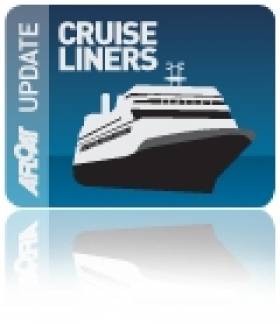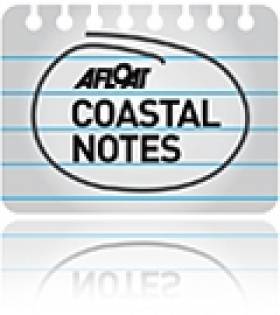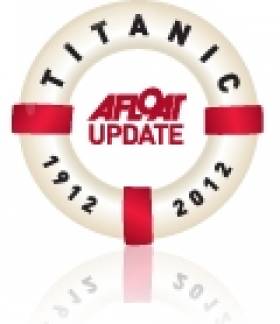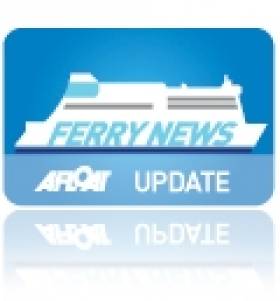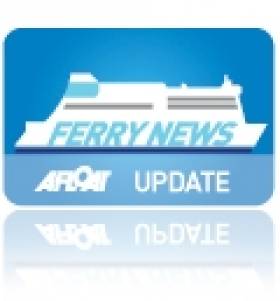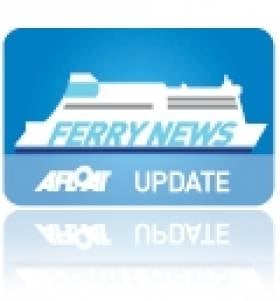Displaying items by tag: Belfast Lough News
Belfast Harbour Boat Tours and WWI Warship Gem
#BELFAST HARBOUR TOURS- If there was ever a time to take a tour of Belfast Harbour, it is now on board the Lagan Boat Company, particularly in light of on-going developments as previously reported to keep the WWI veteran cruiser HMS Caroline in the city, writes Jehan Ashmore.
The 98-year old ship which is the last survivor of the famous Battle of Jutland in 1916, is facing another battle from threat of scrapping or a new life albeit towed to Portsmouth's Historic Dockyard for preservation. Yet there is a campaign to keep the historic ship in the city as tourist attraction.
A great opportunity is provided on board the excursion as the very informative guided-boat tour gives unrivalled access to HMS Caroline moored in Alexandra Dock.
While en-route, the excursion boat which departs from Donegall Quay (several minutes-walk from City Hall), passes the new Titanic Belfast visitor attraction and the world famous symbolic Samson and Goliath cranes at Harland & Wolff.
As the boat enters Alexandra Dock, passengers get very much up close and personal views of HMS Caroline, as the riveted hull complete with portholes looms above. As of a result, one immediately senses a different era in shipbuilding techniques with her cruiser stern and highly flared bow. In addition her distinctive profile of three funnels resembling liners also of old and a tripod foremast.
Since she first came to Belfast in 1924, HMS Caroline has performed various roles. She acted as a floating administrative base during WWII. She then became headquarters and training ship for the Royal Naval Volunteer Reserve in Northern Ireland.
Her career came to an end after 97 years with the Royal Navy, when formally decommissioned by the MoD when reserves transferred to HMS Hibernia (not a ship) in Thiepval Barracks in Lisburn during March 2011. For more about the campaign and proposals to save the ship in her homeport, click HERE
#CRUISE LINERS – This year Belfast Harbour can look forward to a boost in the cruise sector as more than 40 calls are scheduled during the season, the increase is largely attributed to the opening of the iconic visitor attraction of Titanic Belfast, writes Jehan Ashmore.
In 2012 the port is to see an impressive 32% increase on last year with 41 cruise ships bringing almost 75,000 visitors to the port compared to 2011 where 32 ships called with 58,000 passengers.
The ports cruise facility at Stormont Wharf, which cost £10m, continues to pay dividends with its advantage of accommodating large cruise ships operating in the Irish Sea. The wharf at 1km in length is the longest deep-water berth on the island of Ireland.
Among this season's cruise operators visiting the harbour are Cruise & Maritime Voyages (CMV), Fred Olsen Cruise Line, Holland America Line (HAL), P&O Cruises, Prestige Cruises, Princess Cruises and Saga Cruises. Click HERE for a list of cruiseships calling to the port.
#BELFAST HARBOUR -The largest port in the north reported improved turnover and profit during 2010-2011, according to the annual report of Belfast Harbour.
The port showed a 2% rise in profit before taxation to £17.8m and a 4% increase in turnover to £36.1m. Underpinning the harbour's performance were record levels of tonnages handled during the period - up 7% to 17.6m tonnes. Although some sectors, such as those related to construction, continued to struggle, this was offset by growth elsewhere.
The number of freight vehicles passing through the port rose by 14% to 357,000 and a record four million tonnes were handled in the dry-bulk sector, which includes trades such as aggregates and coal.
Belfast Harbour noted that capital expenditure projects valued at £18.3m were completed during 2010-11. A further £53.8m was committed to additional projects at the year end, principally the development of the UK's first dedicated offshore wind logistics terminal for DONG Energy.
Len O'Hagan, Belfast Harbour's Chairman, said: "In spite of ongoing sluggishness in both the UK and Irish economies, Belfast Harbour has posted a very strong set of results for 2011, reflecting the diverse nature of the business and a long-term strategy of major capital investment to ensure that Belfast offers the most modern maritime facilities on the island.
"Significant uncertainty, however, still exists in the global economy, with the UK officially falling back into recession and the continuing eurozone crisis which is undermining business confidence throughout the continent and beyond.
"There are still opportunities for growth, though, particularly in renewable energy where Belfast Harbour is investing £50m in a new terminal for the assembly of offshore wind turbines. There have also been opportunities to further develop Belfast Harbour Estate, not least the Titanic Belfast visitor attraction, which received a £13.6m donation from Belfast Harbour, and the Northern Ireland Science Park which was the subject of a £6m investment by the Harbour to facilitate a 55,000 sq ft expansion."
During the year the port benefitted from several developments within the Irish Sea ferry sector, including the opening of Stena Line's new Scottish terminal at Loch Ryan Port (Cairnryan) and introduction of a pair of larger and more modern vessels. During this timeframe Stena Line had completed its takeover of DFDS Seaways Belfast - Birkenhead route and freight-only service to Heysham.
Mr O'Hagan added: "Although the overall performance of Belfast Harbour has been strong, it is clear that economic recovery across the UK and Ireland remains patchy. Belfast Harbour, however, is committed to its long-term strategy of investing in infrastructure to maintain the Port's competitiveness and provide much needed capital projects for the construction industry."
#BELFAST BASIN CLOSURE – The Belfast Harbour website has a notice informing the temporary closure of the Abercorn Basin over this May Bank Holiday weekend.
The closure times of the basin are from 12.00pm on Sunday 6th May as this is to accommodate the 'Lough to Lagan Flotilla' event to be staged in the area. The facility will re-open as normal at 12.00pm on Monday 7th May.
Incidentally moored nearby on the far side of the Lagan opposite to the entrance of the Abercorn Basin, lies the 87m general dry-cargo ship Union Moon. As previously reported the Cook Island flagged vessel was in a collision with a ferry in Belfast Lough in early March.
Tours of Titanic’s Tender SS Nomadic
#TITANIC'S TENDER - While all the attention is focused on the R.M.S. Titanic and the newly opened Titanic Belfast visitor experience, the White Star Line passenger tender SS Nomadic is only a stone's throw away from the venue, writes Jehan Ashmore.
Like the liner she was built by Harland & Wolff and her launch took place in 1911. She was commissioned by White Star Line as a 1st and 2nd class passenger tender for Titanic and sister Olympic.
The Nomadic carried out her duties based in Cherbourg, where she transferred passengers to the Titanic on her only call to the Normandy port. As such the vessel which is registered in the French port, is the last surviving White Star Line vessel in the world and the only remaining authentic link to the ill-fated liner.
Decades later, the Nomadic became a floating restaurant on the River Seine in Paris close to the Eiffel Tower, where the venture which started in 1977 remained formore than twenty years.
The ageing vessel faced new safety regulations threatening her fate which ultimately led to her being seized in 2002. She was then offered for sale and then followed a court action for her to be scrapped but a campaign was raised to save the historic vessel which succeeded in her securement.
At 95 years old she was towed by barge back to her builder's birthplace in Belfast in 2006. Now that she is over a century old the vessel is currently undergoing restoration by the SS Nomadic Charitable Trust. She is dry-docked in the Hamilton Dock which adjoins the new iconic landmark of the Titanic Belfast building within the developing Titanic Quarter.
Yesterday 'hard-hat' tours began of the preserved liner tender and it is essential to note that tickets are to be 'pre-booked' with the last tour on 15th April. Daily tours are at 10.30, 12 noon, 2pm and the last tour is 3.30pm. To ensure availability visit: www.nomadicbelfast.com/book-a-tour
For further information about the various visitor attractions and events click the following headings, to be directed to the relevant websites.
The history of the S.S. Nomadic
Titanic Belfast Festival (31 March -22 April)
Titanic Belfast Visitor Experience
Following yesterday's inaugural cruise call to Belfast this year of Balmoral as previously reported the Fred. Olsen Cruise Lines vessel was making a cruise in memory of the liner. To see the list of the other cruiseships calling to the city, click HERE.
- RMS Titanic
- SS Nomadic
- White Star Line
- Nomadic Charitble Trust
- Harland & Wolff
- H&W
- Cherbourg
- White Star Line passenger tenders
- Hamilton Dock, Belfast
- Port of Belfast
- Belfast Lough News
- Cruise ships
- Cruise Liners
- Balmoral
- Fred. Olsen Cruise Lines
- Restaurant river Seine boats
- Titanic Belfast
- Titanic Quater
- Titanic Belfast Festival
- RMS Olympic
Historic Days on North Channel Ferry Routes
#FERRY NEWS- In the space of two days, Stena Line opened a new ferry route between Belfast-Cairnryan today following yesterday's closure of services between Belfast-Stranraer, writes Jehan Ashmore.
Sisters Stena Superfast VII and Stena Superfast VIII inaugurated sailings on the 2 hour 15 minute with 12 crossings daily, and in which will use a new £80m ferry terminal at Loch Ryan Port, Cairnryan and the VT4 terminal in Belfast. The relocation of Scottish ports and terminal investment cost £200m.
The newcomers have a capacity for 1,200 passenger /660 vehicles or 110 freight units. They received a refit and upgrade in Poland where new luxurious facilities such as a Nordic Spa, interactive lounge zone with the latest in technology and free Wi-Fi access throughout the vessel and VIP lounges were installed. To read more click HERE.
At 204m and over 30,000 tonnes each the German built pair are easily the largest ever ferries to operate in the North Channel and will compete with rivals P&O Larne-Cairnryan route served by the 20,000 tonnes sisters European Causeway and European Highlander both built in Japan.
The introduction of the former Scandinavian serving sisters directly replaced Stena Caledonia and HSS Stena Voyager from the Belfast-Stranraer route which only started in 1995. Prior to then Stena Line had operated a service from Larne, which could trace ferry services for the last 123 years.
The Swedish ferry company decided to abandon the route in favour of Belfast. This development also saw the introduction of the second revolutionary HSS 1500 series catamaran ferry HSS Stena Voyager in tandem with various conventional tonnage used over the last sixteen years. The final sailings at the weekend marked the closure of nearly 140 years of several ferry operators running between Stranraer at the end of Loch Ryan and Belfast.
With the withdrawal of HSS Stena Voyager and Stena Caledonia yesterday, she joins former fleetmate Stena Navigator in Belfast, which stood down from Stranraer service last week as previously reported, to read click HERE.
Second Stena ‘Superfast’ Ferry is Underway from Poland
The new route to Loch Ryan Port, Cairnryan includes a new £80m ferryport terminal which will be served by the 30,000 gross tonnes sisters, the largest ever ferries on the North Channel. Stena Superfast VIII is currently in the Skagerrak off northern Denmark and follows her sister Stena Superfast VII which arrived over the weekend, having also undergone refurbishment at the Romentowa shipyard.
The relocation of Scottish terminal from Stranraer to Loch Ryan Port is seven miles closer to the open sea and sailing times are to be reduced to 2hrs and 15minutes. The new terminal is to be officially opened on 25th November when First Minister of Scotland Alex Salmond and Deputy First Minister of Northern Ireland Martin McGuinness will join Dan Sten Olsson, Chairman of Stena Line.
As for the 15,229 gross tonnes Stena Navigator, she made her Stranraer-Belfast sailing yesterday, after de-storing at the VT4 ferry terminal, only completed in 2008, she proceeded to berth at Albert Quay, the location of the former city-centre ferry terminal.
In the interim period to the opening of the new Belfast-Cairnryan route, the sailing schedule on the Belfast-Stranraer service are been maintained by another conventional ferry, Stena Caledonia and fast sailings by the HSS Stena Voyager.
HSS Stena Voyager is expected to lay-up at VT4 after making final sailings to and from Stranraer this Sunday. It is expected Stena Caledonia will also be withdrawn that day and berth at Albert Quay. In the process she will pass Harland & Wolf shipyard, where she was launched in 1981 as the St. David, the last of the quartet of Saint-class ferries commissioend for Sealink/British Rail.
The career of Stena Navigator on the North Channel was short as she only entered service two years ago. She was built in 1984 as Champs Elysees first served for SNCF/Sealink's jointly run Dover-Calais route, followed by a brief spell under Stena Line as Stena Parisien on Newhaven-Dieppe sailings.
She returned to the Straits of Dover route but this time as SeaFrance Manet under the control of SeaFrance. In 2008 SeaFrance introduced SeaFrance Moliere, the former Superfast X, ironically another sister of Stena Line's 'Superfast' ships. This Superfast vessel along with two custom built newbuilds entered SeaFrance service in recent years which led to the eventual replacement of SeaFrance Renoir and her half sister SeaFrance Manet.
- Port of Belfast
- Stena Line
- Ports and Shipping News
- Ferry news
- Loch Ryan Port
- HSS Stena Voyager
- St. David
- SeaFrance
- DoverCalais
- Belfast Lough News
- Sealink
- H&W
- BelfastCairnryan
- Stena Superfast sisters
- Loch Ryan Port Cairnryan
- Romentowa
- Harland & Wolf
- Sealink/British Rail
- SaintClass sisters
- SNCF
- Straits of Dover
- Attica
- VT4 Terminal
- Loch Ryan Scotland
- Sealink British Rail
Stena Superfast VII Departs Poland for New Belfast-Cairnryan Route

The New Superfast leaves Gdansk
The 30,285grt newcomer and her sister Stena Superfast VIII will become the largest ever ferries running on the North Channel , though prior to entering service on 21 November, they will undertake berthing trials and crew training.
For the next two-years the sisters are on charter from Scandinavian operators Tallink, and are to operate the new 2 hour 15 minute route with 12 crossings daily. The ten-deck ships can carry up to 1200 passengers, 660 cars or 110 freight units. The sisters will be re-gistered in their new homport of Belfast.
The relocation of Scottish ferry port and the introduction of the Superfast sisters will replace the existing pair of conventional ferry tonnage, Stena Caledonia and Stena Navigator (1984/15,229gt) the latter vessel is believed to be sold. In addition HSS sailings will cease causing the HSS Stena Voyager to become redundant, she was the second of the trio of pioneering HSS 1500 craft built.
When Stena Superfast VII departed Gdansk, she passed the Stena Vision which operates Stena Line's Karlskrona-Gdynia route, the Baltic Sea city lies to the west of Gdansk. Also in Gdansk was the Stena Feronia, the former Irish Sea serving Visentini built ro-pax Dublin Seaways, which was operated albeit briefly by DFDS Seaways last year on the Dublin-(Birkenhead) Liverpool service.
She served under her new Scandinavian owners but the firm's first foray into the Irish market lasted a mere six months. DFDS Seaways sold their Irish Sea network to Stena Line (to read report click HERE) with the exception of their Dublin-Birkenhead service which closed. In addition the Dublin-Heysham freight-only route which closed until re-opened by Seatruck Ferries. The route is currently served by Anglia Seaways, the freightferry which DFDS previously used on the route is on charter to the operator.
- DFDS Seaways
- Baltic Sea
- Stena Line
- Ports and Shipping News
- Seatruck Ferries
- North Channel
- Stranraer
- Dublin Seaways
- Ferry news
- Tallink
- Loch Ryan Port
- HSS Stena Voyager
- Stena Caledonia
- Stena Navigator
- Belfast Lough News
- HSS
- Visentini ropax
- BelfastCairnryan
- Stena Superfast VII
- Stena Superfast VIII
- Stena Superfast
- Superfast Sisters
- North Channel ferry routes
- Stena Feronia
- LRP
- BirkenheadBelfast
- DublinBirkenhead
Sponsorships of Ice-Sea Giants
Stena Line themselves will be looking forward to introducing their own giants when two of the largest ferries are to be introduced on the North Channel in the Autumn. The two chartered 30,000grt sisterships are Superfast VII and Superfast VIII. To see the vessel breaking through an an ice-flow, click PHOTO. The 203m long pair can take 1,200 passengers, around 660 cars or 110 freight vehicles. To read more about these 'Superfast' class vessels and the new £80 port terminal click HERE.
The company's area director Michael McGrath said: "It's quite fitting that we are teaming up with the Stena Line Belfast Giants at this time as we prepare to introduce two of the largest ferries every to sail between Northern Ireland and Scotland when we open our new route and port in Cairnryan this November. The two Superfast vessels will be another two Giants to add to our team."
Last year Stena Line made a £40m acquisition of the Belfast to Liverpool (Birkenhead) and Heysham routes and four vessels from DFDS Seaways. The deal was approved by the Irish authorities but remained subject to clearance from the UK's Competition Commission until late last month when they fully approved the acquisition.
This brings to six routes the company runs on its Irish Sea route network where over two million passengers were carried each year, more than its rival ferry operators combined.
- DFDS Seaways
- Belfast Harbour
- Stena Line
- North Channel
- Competition Commission
- BelfastHeysham
- Superfast VII
- Superfast VIII
- Belfast Lough News
- Belfast Port
- Odyssey Arena
- Belfast Giants
- BelfastCairnryan
- New ferryport
- Nottingham Panthers
- Sheffield Steelers
- Hockey Festival Weekend
- BelfastLiverpool (Birkenhead)
- Irish Sea ferry companies
- Irish icehockey
Prior to her arrival on the North Channel, Norcape had been laid-up in Liverpool since February 2010 after the former B+I Line vessel (MV Tipperary) was replaced by European Endeavour on the central corridor route to Dublin. As of this week the ro-pax freight vessel which has been running in a freight-only mode will now carry motorists likewise to her route fleetmates Norbank and Norbay.
With the departure of European Mariner from the Irish Sea, she follows a trio of former Stena Line freight-ferry sisters which were made redundant since the closure of the Belfast-Heysham route late last year. It is believed the sisters Stena Seafarer, Stena Leader and Stena Pioneer have been sold to Russian interests to serve in the Black Sea in connection to the 2014 Winter Olympics in Sochi.
The sisters were renamed, Stena Pioneer became Ant 1, Stena Seafarer is the Ant 2 and Stena Leader is the Anna Marine. They departed Belfast Lough in mid-June to Sevastopol in the Ukraine under the Moldovan flag and with a port of registry in Giurgiulesti.
- Port of Larne
- Belfast Lough
- Stena Line
- Ports and Shipping News
- RoPax
- North Channel
- P&O (Irish Sea)
- B+I Line
- European Endeavour
- Ferry news
- Belfast Lough News
- RosslareFishguard
- LarneTroon
- European Mariner
- Freightferries
- MV Tipperary
- Central Coridoor route
- BelfastFleetwood
- Stena Europe ferry
- 2014 Winter Olympics
- Sochi
- Black Sea
- Turkish shipbreakers
- Izmir
- Turkey
- Winter Olympics 2014
- Irish Sea ferry motorists



























